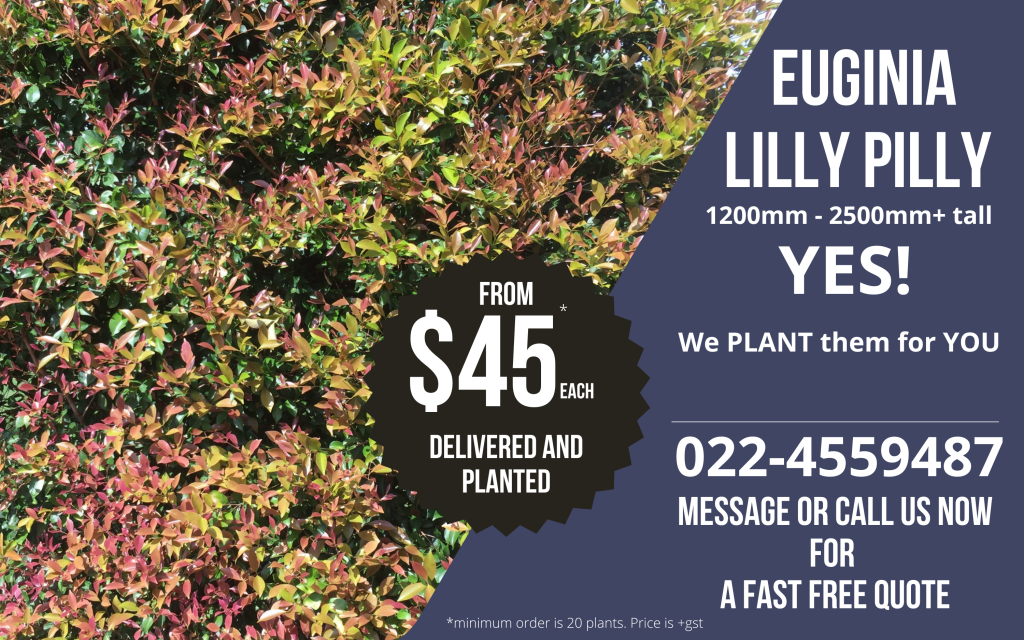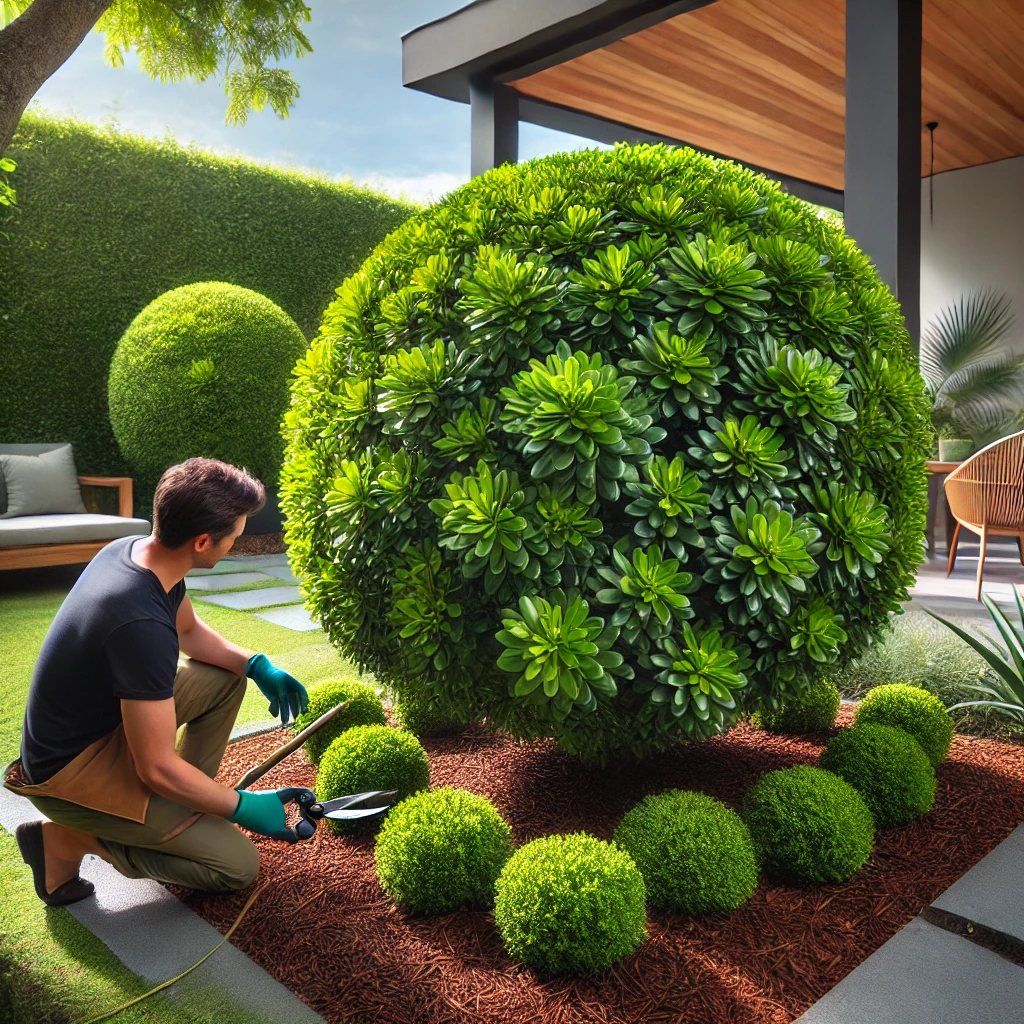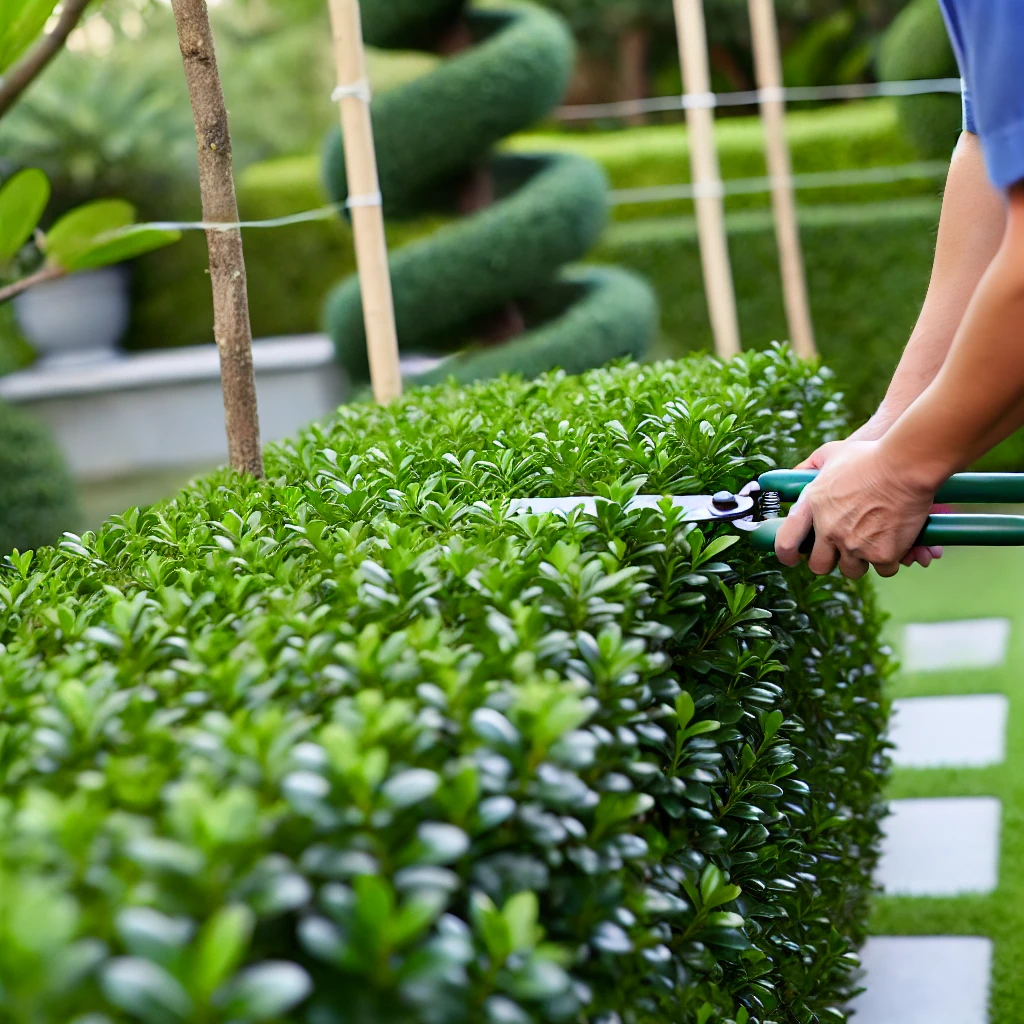Lilly Pilly For Sale From 1 meter to 2.5m tall delivered and planted Auckland wide & throughout the North Island. Call us now to see what we currently have in stock

The Rich History of Eugenia Lilly Pilly: A Journey Through Time
The Eugenia Lilly Pilly, a plant adored by gardeners for its glossy foliage and vibrant berries, carries a fascinating history that dates back centuries. This evergreen shrub, also known as Syzygium, has deep roots in the cultures and landscapes of Australia and beyond. Today, it graces gardens worldwide, but its journey from the wild to our backyards is as captivating as the plant itself.
The Origins of Eugenia Lilly Pilly
The story of Eugenia Lilly Pilly for sale begins in the lush rainforests of Australia and Southeast Asia. Indigenous Australians first recognized its value, using the plant for both culinary and medicinal purposes. The berries, which vary in colour from bright pink to deep red, were a staple in their diet. They often used the fruit in jams, jellies, and even fermented beverages. The Indigenous people also utilized the plant’s leaves and bark for their antibacterial properties, applying them to wounds to prevent infections.
In the wild, Lilly Pilly thrived under the canopy of dense forests. It adapted well to a variety of conditions, which explains its widespread presence across different regions. Its ability to grow in both tropical and temperate climates allowed it to flourish in diverse environments. Over time, different species of Lilly Pilly emerged, each adapting to its specific habitat.
European Discovery and Cultivation
European settlers first encountered Lilly Pilly during their explorations of Australia in the 18th century. Botanists and explorers, fascinated by the plant’s resilience and beauty, collected specimens and seeds. They quickly recognized its potential as an ornamental plant. Soon, they began cultivating it in European gardens. The plant’s hardiness and adaptability made it a favourite among gardeners, who appreciated its ability to withstand various climates.
In Europe, the Lilly Pilly found a new role as a decorative plant. Gardeners prized it for its glossy leaves and ability to be shaped into hedges and topiaries. The plant’s vibrant berries added a splash of colour to gardens during the winter months, making it a popular choice for ornamental use. The tradition of using Lilly Pilly for sale nz in formal garden settings began, and it soon became a symbol of elegance and sophistication.
The Spread to the New World
The 19th century saw the spread of Eugenia Lilly Pilly to the Americas and other parts of the world. Botanists transported the plant to the United States, where it quickly gained popularity as a landscape plant. In California and Florida, gardeners admired Lilly Pilly for its lush foliage and year-round appeal. It became a common sight in public parks and private gardens alike.
As Lilly Pilly’s popularity grew, so did the demand for different varieties. Hybridization efforts led to the development of new species with varying leaf colours, berry sizes, and growth habits. These hybrids allowed gardeners to choose plants that best suited their specific needs, whether they wanted a compact shrub for a small garden or a tall hedge for privacy.
Lilly Pilly in Modern Landscaping
Today, Eugenia Lilly Pilly plays a significant role in modern landscaping. Gardeners and landscapers value the plant for its versatility, using it in everything from formal hedges to casual garden borders. Its ability to thrive in a range of soil types and climates makes it a reliable choice for gardeners worldwide.
One of the reasons Lilly Pilly remains so popular is its low maintenance requirements. Once established, the plant requires minimal care, making it an ideal choice for busy homeowners. It is drought-tolerant, pest-resistant, and responds well to pruning, allowing it to be shaped into various forms. This adaptability has ensured its place in both traditional and contemporary garden designs.
In Australia, where it originates, Lilly Pilly continues to hold cultural significance. Many Australian gardeners plant it as a nod to their country’s rich botanical heritage. The plant’s berries are still used in culinary applications, with chefs incorporating them into sauces, desserts, and even cocktails. The Lilly Pilly has thus transitioned from a bush tucker staple to a gourmet ingredient, reflecting its enduring versatility.
The Role of Lilly Pilly in Sustainable Gardening
In recent years, Lilly Pilly has gained attention for its role in sustainable gardening. Its dense foliage provides excellent habitat for native birds and insects, supporting local biodiversity. The plant’s ability to absorb carbon dioxide also makes it a valuable addition to eco-friendly gardens. Gardeners can use Lilly Pilly to create green barriers that not only offer privacy but also contribute to environmental health.
Lilly Pilly’s resilience to pests and diseases means that gardeners can maintain it without relying on chemical treatments. This natural resistance further enhances its appeal as a sustainable garden choice. As more people seek to reduce their environmental impact, plants like Lilly Pilly are likely to become even more popular.
Cultivating Lilly Pilly: Tips for Gardeners
For those interested in cultivating Lilly Pilly, the process is straightforward. The plant thrives in well-drained soil and benefits from regular watering during its establishment phase. It prefers a sunny spot but can tolerate partial shade. Pruning should be done after flowering to maintain its shape and encourage dense growth.
Lilly Pilly can be propagated from seed, but most gardeners prefer using cuttings for faster results. When planting multiple Lilly Pilly’s for a hedge, space them about 50-100 centimetres apart to allow room for growth. With proper care, a Lilly Pilly hedge can grow rapidly, providing privacy and beauty for many years.
Conclusion: Lilly Pilly’s Enduring Legacy
The history of Eugenia Lilly Pilly is a testament to its adaptability and enduring appeal. From its origins in the Australian bush to its place in gardens around the world, Lilly Pilly has proven itself as a plant of great versatility and charm. Whether used in traditional landscapes or modern sustainable gardens, Lilly Pilly continues to captivate gardeners with its beauty and resilience. As you plant your own Lilly Pilly, you’re not just adding a beautiful shrub to your garden—you’re participating in a rich history that spans centuries and continents.
Eugenia Hedge Care: Tips for Lush, Green Growth Year-Round
A Eugenia hedge is a dream come true for anyone looking to create structure and elegance in their garden. With their lush green foliage, rapid growth, and versatility, these hedges can transform any outdoor space into a private sanctuary or a polished masterpiece.

However, maintaining that signature vibrant appearance throughout the year requires a little attention and care. Whether you’re just planting your first Eugenia hedge or looking to revive an older one, the right approach can make all the difference.
When I planted my first Eugenia hedge, I was captivated by how quickly it began to fill out, creating a rich, green barrier along my property line. It was exactly what I needed for privacy and added an air of sophistication to the space.
However, I quickly learned that the lush, glossy foliage I loved so much didn’t maintain itself. It took some trial and error, but I eventually developed a routine that keeps my hedge looking healthy and vibrant no matter the season.
Planting is the first step to ensuring your Eugenia hedge thrives. Choosing the right location is critical. Eugenia loves sunlight, so planting it in a spot that gets at least six hours of direct sunlight a day is ideal. When I planted mine, I made sure to enrich the soil with compost to give the roots a strong start.
Well-draining soil is also important; standing water can cause root rot, a common problem with Eugenia hedge. I learned this lesson the hard way when one section of my hedge began to yellow and wilt. Improving the drainage solved the issue and saved the hedge from further damage.
Watering is a balancing act with Eugenia. When the plants are young, they need regular watering to help establish their roots. I watered mine deeply twice a week for the first year, ensuring the soil remained moist but not soggy.
Once established, Eugenia becomes more drought-tolerant, but occasional deep watering during dry spells helps maintain its lush appearance. I’ve found that mulching around the base of the hedge helps retain moisture and keeps the roots cool during the hot summer months.
Pruning is where the magic happens. Regular trimming encourages bushier growth, giving your hedge that dense, uniform look. I like to prune my Eugenia hedge every few months, focusing on shaping it in late winter or early spring and then giving it a light touch-up in late summer. Using sharp, clean shears ensures a neat finish and reduces the risk of disease.
One year, I got a little overzealous and trimmed too much, too late in the season, which left the hedge looking sparse for a few months. Since then, I’ve learned to prune strategically and avoid heavy cuts just before the cooler months.
Feeding your hedge is another essential part of keeping it healthy. I use a balanced slow-release fertilizer twice a year, once in spring and again in early autumn.
This gives the plants the nutrients they need to produce vibrant foliage and maintain strong growth. For an extra boost, I occasionally water my hedge with a liquid seaweed solution, which seems to enhance the color and overall vitality of the leaves.
Like any plant, Eugenia can face challenges, and pests are a common one. Scale insects and psyllids are two culprits that can cause problems if left unchecked. I’ve dealt with scale on my hedge before and found that wiping the affected areas with a cloth soaked in soapy water did the trick.
For more persistent infestations, I’ve used neem oil, which is both effective and environmentally friendly. Keeping the hedge healthy through proper watering and feeding also makes it more resistant to pests and diseases.
Winter can be a tricky time for Eugenia, especially in areas that experience frost. While the plant is relatively hardy, prolonged exposure to freezing temperatures can cause leaf burn or even damage the roots. In my garden, I’ve used frost cloth to cover the hedge during particularly cold snaps, and it’s been a lifesaver. For gardeners in colder climates, planting Eugenia in a more sheltered location can provide additional protection.
What I love most about Eugenia is how rewarding it is to care for. Every season offers an opportunity to nurture the hedge and enjoy its transformation. In spring, the bright new growth is a welcome sign of life after the colder months.
In summer, the hedge becomes a vibrant backdrop for outdoor gatherings, providing shade and privacy. Even in winter, its evergreen foliage adds a touch of color to the garden, standing out against the more muted tones of the season.
One of my favorite memories involving my Eugenia hedge was when a neighbor complimented it during a summer barbecue. She asked how I kept it so vibrant, and I happily shared my routine, feeling a sense of pride in how far my gardening skills had come. Now, her hedge looks just as stunning, and we often exchange tips on keeping our gardens in top shape.
Caring for a Eugenia hedge may take a bit of effort, but the rewards are well worth it. Its ability to bring beauty, privacy, and structure to any garden makes it an invaluable addition. With proper planting, regular care, and a little patience, your hedge will thrive, adding lush greenery and elegance to your outdoor space for years to come.
Whether you’re creating a formal boundary or simply adding some natural charm to your yard, Eugenia hedges are a timeless choice that never fails to impress.
How to Shape and Style Your Eugenia Hedge Like a Pro
There’s something incredibly satisfying about a perfectly shaped hedge. It adds structure, elegance, and a polished touch to any garden. Eugenia hedge, with it’s dense, glossy foliage, are particularly well-suited for shaping and styling.

Whether you’re going for clean, geometric lines or a softer, more organic look, mastering the art of hedge trimming can transform your outdoor space. Shaping your Eugenia hedge like a pro doesn’t require fancy tools or years of experience with just a little patience, a steady hand, and some tried-and-true techniques.
When I planted my first Eugenia hedge, I was both excited and nervous about the idea of shaping it. I envisioned a neat, symmetrical boundary along my garden path but had no idea where to start.
My early attempts were far from professional, with uneven edges and a slightly lopsided appearance. Over time, though, I discovered a few techniques that made all the difference. Now, trimming and styling my hedge has become one of my favorite gardening tasks.
The first step to shaping a Eugenia hedge is understanding its growth habits. Eugenia grows quickly and evenly, making it ideal for precise trimming. Its dense foliage allows you to create sharp edges and clean lines, or you can let it grow slightly fuller for a softer, more natural look.
Before you start trimming, it’s helpful to have a clear idea of the shape you want to achieve. For my hedge, I decided on a classic rectangular shape, which provides a tidy, formal feel to my garden.
One of the best tips I’ve learned is to start by marking out your desired shape. I use stakes and string to create a guide, which helps me stay on track and avoid cutting too much. If you’re going for a rounded or freeform look, visualizing the shape beforehand is equally important. For curves, I like to step back frequently during trimming to check the overall balance and symmetry.
Using the right tools is essential for achieving professional results. Sharp hedge shears or electric trimmers work best for Eugenia hedge as they make clean cuts that promote healthy growth.
When I first started, I used an old pair of dull shears, which left uneven edges and damaged the foliage. Investing in a good-quality pair of shears made a world of difference. For detailed work, like shaping the top corners or adding curves, I also use hand pruners for more control.
Timing plays a crucial role in shaping your Eugenia hedge. I’ve found that trimming twice a year, in late spring and late summer, is ideal. These times align with the hedge’s active growth periods, allowing you to shape it effectively without stressing the plants. Trimming during these periods encourages denser growth, which is key for maintaining a full, lush appearance.
When shaping, always start at the top of the hedge and work your way down. This ensures that cut branches and leaves don’t get caught in the foliage below, leaving a clean finish. For straight lines, I keep the shears parallel to the ground and use long, even strokes.
For curves or rounded shapes in my eugenia hedge I move more slowly, focusing on gradual adjustments to maintain smooth, natural lines. Early on, I learned to resist the urge to over-trim—cutting too much can leave gaps and make the hedge look sparse.
One of the most rewarding aspects of shaping a Eugenia hedge is how quickly it recovers and fills out. After a trimming session, I usually notice fresh growth within a couple of weeks. To help the hedge recover and maintain its vibrancy, I like to apply a balanced fertilizer after trimming. A light watering also helps settle the soil and supports healthy regrowth.
I’ll never forget the first time a neighbor complimented my hedge. She asked how I managed to get such straight lines and consistent growth, and I proudly shared my routine. Since then, she’s started shaping her own Eugenia hedge, and it’s been fun to trade tips and see how our styles differ.
While her hedge features rounded, cloud-like shapes, mine remains clean and angular, reflecting our personal tastes.
For gardeners looking to experiment, a Eugenia hedge offers endless possibilities for creative styling. I’ve seen hedges shaped into spirals, arches, and even animal topiaries. While I haven’t tried anything quite so elaborate yet, I’ve started incorporating subtle curves into my hedge to soften the edges and add a bit of character. The beauty of Eugenia is its flexibility it adapts to almost any design, from traditional to contemporary.
Shaping and styling a hedge might seem daunting at first, but with practice, it becomes an enjoyable and rewarding part of gardening. Eugenia’s resilience and rapid growth make it forgiving of mistakes, so don’t be afraid to experiment and refine your technique.
For me, trimming my hedge is more than just maintenance, it’s a creative process that allows me to connect with my garden and express my personal style.
A well-shaped Eugenia hedge doesn’t just enhance your garden, it transforms it. Whether you’re framing a pathway, creating a privacy screen, or adding structure to a sprawling landscape, the right shape can elevate your outdoor space to a new level of elegance. With a little time, effort, and the right approach, you can shape and style your Eugenia hedge like a pro, turning it into a stunning centerpiece that reflects your vision and care.
